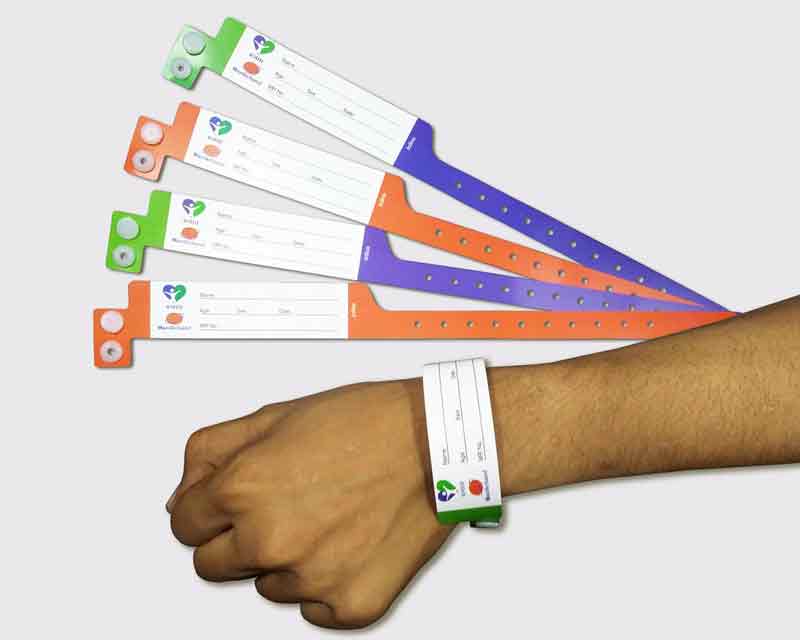How a Patient Identification Band Improves Patient Care and Reduces Hazards
How a Patient Identification Band Improves Patient Care and Reduces Hazards
Blog Article
Checking Out the Different Sorts Of Patient Identification Band Made Use Of in Medical Facilities
In the complex world of medical care, the critical function of Patient Identification bands frequently goes undetected. These bands, differing from straightforward paper wristbands to sophisticated RFID bands, form the foundation of Patient security procedures, making sure accuracy in Patient Identification.
Comprehending the Significance of Patient Identification Bands
While they may appear like plain devices, Patient Identification bands play an essential function in medical facilities. These bands serve as an essential device for verifying Patient identity, avoiding medical mistakes connected to misidentification. Patient Identification bands additionally aid in improving administrative jobs, making sure precise record-keeping and billing.
Typical Paper Wristbands: Their Usage and Limitations
Standard paper wristbands have actually been a staple in Patient Identification across various medical facilities. While their use is extensive, they nurture particular constraints that may impact their efficiency in Patient monitoring. This area will concentrate on the scope of their application and the intrinsic drawbacks related to their use.
Paper Wristbands: Usage Extent
In the world of Patient Identification, paper wristbands have long held a vital role. These bands are commonly made use of in outpatient setups, where the Patient's remain is momentary. In spite of developments in innovation, the modest paper wristband remains a trusted and cost-effective remedy for Patient Identification in numerous medical care circumstances.
Limitations of Paper Wristbands
Despite their widespread usage, paper wristbands are not without their drawbacks. Their physical sturdiness is among the considerable constraints. Direct exposure to water, sweat, or harsh handling can render them unreadable or even trigger them to degenerate. On top of that, paper wristbands often lack the technical capacities of even more modern options, such as barcoding or RFID chips, restricting their functionality to simply presenting written details. The lack of ability to upgrade or customize the data on the wristband is one more drawback. Furthermore, if the information is handwritten, legibility can be compromised, causing prospective misidentification. Paper wristbands can create discomfort or skin irritability to some people, especially when put on for extended periods.
Barcoded Wristbands: Advancements in Patient Identification
While Patient Identification has actually long been a crucial facet of healthcare, the arrival of barcoded wristbands symbolizes a considerable jump ahead. These bands leverage the simpleness of barcoding technology, permitting for Patient details to be swiftly scanned and accessed. They improve the rate and accuracy of Patient Identification, decreasing the risk of medical mistakes related to misidentification.
Superhigh Frequency Identification (RFID) Bands: an Action Towards Futuristic Medical Care
The evolution of Patient Identification bands has caused the development of Radio Regularity Identification (RFID) Bands (patient identification band). These ingenious gadgets present essential advantages for health care facilities, offering a more efficient and technologically advanced methods of Patient Identification. The execution of RFID in medical care is a considerable step towards an extra futuristic method to Patient monitoring and security
Understanding RFID Bands

RFID Bands: Key Advantages
Welcoming a future where technology and healthcare merge, superhigh frequency Identification bands supply numerous crucial advantages. Mostly, these bands enhance Patient security by supplying precise, immediate Identification, therefore decreasing clinical mistakes. RFID bands can keep a vast amount of Patient information, including medical history and allergies, making it possible for customized care. They also enhance administrative tasks, as the automated information access changes hand-operated processes, improving effectiveness and lowering documents. RFID bands provide real-time monitoring of people, essential in high-risk settings such as surgical treatment or intensive treatment. Lastly, these bands are sturdy and resistant to environmental aspects, guaranteeing regular performance. In general, RFID bands stand for a significant development navigate here in Patient Identification modern technology, profiting both patients and medical care companies.
Carrying Out RFID in Medical Care
These bands supply a smooth method to track and recognize individuals, ensuring their safety and security and improving effectiveness in treatment procedures. RFID bands lower medical errors by giving exact Patient Identification, which is essential in stopping misdiagnosis or incorrect medicine management. Thus, the execution of RFID bands is a substantial action in the direction of enhancing Patient safety and healthcare delivery.

Color-Coded Wristbands: Aiding in Quick and Accurate Diagnosis
In the bustling setting of a medical facility, color-coded wristbands have actually emerged as crucial devices for swift and accurate Identification of a client's clinical condition. These wristbands, put on by clients, lug particular shades that correspond to different clinical conditions or conditions. This system is designed to use immediate aesthetic cues to health care companies, enhancing Patient safety and care high quality.
Strategies for Reliable Implementation and Monitoring of Patient ID Bands
Achieving optimal use of Patient Identification bands requires a well-structured approach for their implementation and administration. Patient education and learning is likewise important; individuals need to recognize the function of the bands and the requirement for their consistent wear. It's important to have a backup plan in area, such as barcode scanning or biometrics, to make certain that Patient Identification is never compromised.
Conclusion
Patient Identification bands are important in medical facilities to make certain safety and precision. Effective implementation and monitoring of these bands can considerably minimize medical errors, enhance efficiency, and boost overall Patient treatment.
These bands, varying from basic paper wristbands to advanced RFID bands, develop the foundation of Patient security methods, making sure accuracy in Patient Identification.The go advancement of Patient Identification bands has actually brought about the appearance of Radio Regularity Identification (RFID) Bands. In general, RFID bands represent a substantial development in Patient Identification innovation, profiting both clients and medical care providers.
RFID bands lower medical mistakes by supplying precise Patient Identification, which is vital in avoiding misdiagnosis or incorrect medication administration. Patient education and learning is basics likewise critical; clients must comprehend the purpose of the bands and the demand for their consistent wear.
Report this page